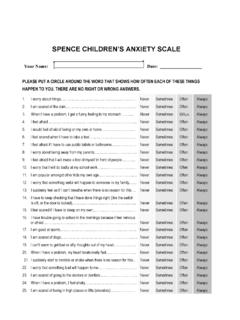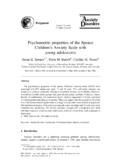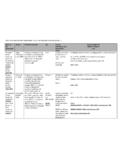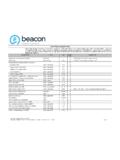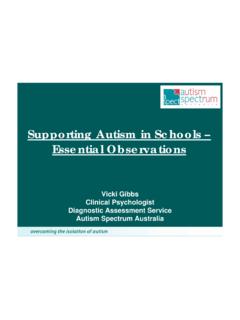Transcription of The structure of anxiety symptoms among …
1 Behaviour Research and Therapy 39 (2001) 1293 structure of anxiety symptoms among preschoolersSusan H. Spencea,*, Ronald Rapeeb, Casey McDonalda, Michelle IngrambaSchool of Psychology, University of Queensland, Brisbane, Queensland 4072, AustraliabMacquarie University, AustraliaAccepted 29 September 2000 AbstractThis study examined whether anxiety symptoms in preschoolers reflect subtypes of anxiety consistentwith current diagnostic classification systems, or should be better regarded as representing a single dimen-sion. Parents of a large community sample of preschoolers aged to years rated the frequency withwhich their children experienced a wide range of anxiety problems. Exploratory factor analysis indicatedfour or five factors and it was unclear whether separation anxiety and generalized anxiety representeddiscrete factors.
2 Results of confirmatory factor analyses indicated a superior fit for a five-correlated-factormodel, reflecting areas of social phobia, separation anxiety , generalized anxiety , obsessive compulsivedisorder and fears of physical injury, broadly consistent with DSM-IV diagnostic categories. A high levelof covariation was found between factors, which could be explained by a single, higher order model, inwhich first order factors of anxiety subtypes loaded upon a factor of anxiety in general. No significantdifferences were found in prevalence of anxiety symptoms across genders. symptoms of PTSD in thissample were rare. 2001 Elsevier Science Ltd. All rights : anxiety ; preschool ; Children; Confirmatory factor analysis1.
3 IntroductionAs a consequence of lack of research, we know relatively little about anxiety problems amongpreschoolers (Campbell, 1995). For example, there is minimal information about the prevalenceof anxiety disorders in preschoolers. Although it is widely accepted that preschoolers may manifestpatterns of behaviour that meet diagnostic criteria for anxiety disorders, such as separation anxiety ,social phobia and simple phobias, this has not been demonstrated conclusively with large scalepreschool community samples. Despite the occasional inclusion of preschoolers in epidemiological* Corresponding author. Tel.:+617-33656220; fax:+ ( Spence).0005-7967/01/$ - see front matter 2001 Elsevier Science Ltd. All rights : S 0005-7967(00) Spence et al.
4 / Behaviour Research and Therapy 39 (2001) 1293 1316studies, their data have not been analysed and reported separately ( , Bird et al., 1988). Theminimal evidence available comes from studies that have examined fears of specific stimuli, ratherthan anxiety symptoms , among preschoolers. For example, Richman, Stevenson and Graham(1975) reported that of 3-year old children in their sample were rated as showing severefears. Ialongo, Edelsohn, Werthamer-Larsson, Crockett and Sheppard (1994, 1995) consideredaround of a sample of 5-year olds to show severe anxiety symptoms , and found such prob-lems to be relatively stable over a 4-month period. Furthermore, Ialongo et al. (1994, 1995)subsequently found that self-reported anxious symptoms at 5 years significantly predicted adaptivefunctioning 4 years later.
5 Children who were in the top third of anxious symptoms infirst gradewere 10 times more likely to be in the bottom third of achievement infifth grade, even aftercontrolling for level of adaptive functioning infirst information demonstrates the need to take anxiety problems seriously, but provides littleinsight into the forms that more specific types of anxiety may take. There is clearly a need forlarge-scale epidemiological studies with preschoolers that include a focus on specific anxietydisorders and symptoms . We also have little knowledge about the consequences being a highlyanxious preschooler, and about patterns of comorbidity between specific anxiety disorders andother forms of psychopathology.
6 Similarly, little is known about the stability of preschool anxietyproblems, and the extent to which they are a precursor of anxiety disorders in later phases of also have minimal data relating to the aetiology of preschool anxiety problems and factorsthat determine which children will continue to show anxiety problems over time, where otherswill grow out of their difficulties. Clearly, there are far more questions than answers in this few studies to date relating to preschool anxiety represent explorations of the nature anddevelopmental differences in fears of specific objects or events among non-clinical children,although again very few have focused specifically upon preschool populations.
7 These studies doprovide some interesting insights into the nature of preschool children s anxiety . For example,Jersild and Holmes (1935) in their classic study asked mothers to report on fears in their 2 6year old children. Mothers reported that their children showed an average of four tofive fears ofspecific events or stimuli. In terms of content of fears, Maurer (1965) asked children aged 5 14years to report what are the things to be afraid of . The results were striking in that the highestlevel of fears reported by 5 6 year olds related to animals (particularly bears, lions, snakes andtigers) and this effect showed a marked decline with age. Bauer (1976) also reported this aged 4 6 years reported a high level of fears of animals and imaginary creatures andboth these areas of fears declined with age.
8 In contrast, both studies showed relatively low levelsof fears of natural disasters and bodily injury/physical danger in this very young age group, withthese categories of fears increasing with age. Both authors noted the developmental shift fromfears of imaginary and unrealistic fears towards more realistic and specific events with increasingcognitive shift in the content of children s fears is also reflected in the content of children example, Vasey, Crnic and Carter (1994) demonstrated that preschool children are capable ofreporting on the cognitive components of worry. However, Vasey et al. (1994) found that the contentand complexity of worrisome thoughts increased with age and cognitive ability.
9 In their 5 6yearold sample, worries relating to physical well-being ( injury or kidnapping) predominated. Withincreasing cognitive and self-concept development, the worries of older children (8 12 years) relatedmore often to behavioural competence, social evaluation and psychological Spence et al. / Behaviour Research and Therapy 39 (2001) 1293 1316 One of the main barriers to research into preschool anxiety is the lack of reliable and validassessment devises. The majority of parent/teacher questionnaires or checklists, or clinicianadministered diagnostic interviews for assessment of preschool anxiety represent adaptations ofmeasures developed, standardized and validated with much older children or adults.
10 Examplesinclude the Louisville Fear-Survey (Miller, Barrett, Hampe & Noble, 1972), modifications of theFear Survey Schedule for Children-Revised (Ollendick, 1983; Bouldin & Pratt, 1998) and AnxietyDisorders Interview Schedule for Children (Silverman & Albano, 1996). Other parent and teacherreports, using child behaviour checklists ( , Achenbach, 1992; Quay, 1983; Behar, 1977),tend to cover more global aspects of internalizing behaviours, and patterns of anxious/withdrawn/depressive behaviour, and provide little information about specific few studies have attempted to modify child self-report measures designed for older children,such as the Revised Children s Manifest anxiety Scale (Reynolds & Richmond, 1978) or theState-Trait anxiety Inventory for Children (Spielberger, 1973).

